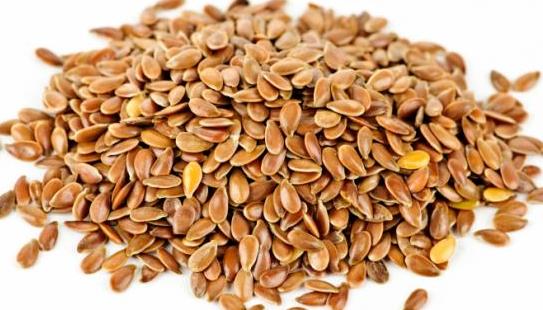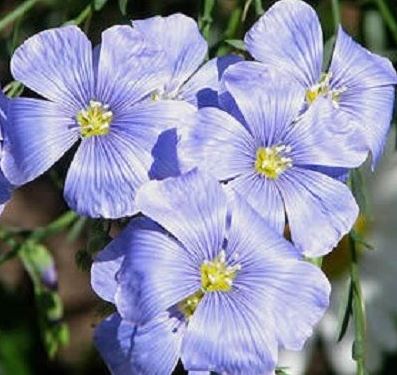Flaxseed Farming Guide:
Introduction of Flaxseed Farming:- Flax crop is a cool season herbaceous annual plant crop with a short taproot system. Flaxseed is also called linseed. Flax or Flax seed belongs to the genus of “Linum”. Mediterranean region is the primary centre of origin of flax and from here it spread to other regions of the world. Flax seed or Linseed is gaining popularity throughout the world due to its excellent health benefits and commercial use. Basically this crop is grown for food, fiber and oil. Mainly Flax is being used in text tile industries apart from using this as food and oil. Some people can grow these plants for ornamental purpose as well. There is a possibility of good profits in commercial cultivation of Flaxseed as they have good demand in domestic and international markets.
When it comes to flax plant description, usually a flax plant grows about 3 to 4 ft. with slender stems. Flax plant flowers will have 5 petals with diameter of 15 to 20 mm and the common colour of flax plant flower is pale blue. The seeds from flax plant are in round shape and dry capsule is about 5 to 8 mm in diameter and 4 to 6 mm long. Oil content of the Flaxseed is about 35 to 40%. The linseed oil cake is used as manure and cattle feed. Flaxseeds occur in two basic varieties: brown and yellow or golden. Canada is the largest producer of Flaxseed, producing nearly 30 % of the world’s total production. The following talks about growing flax seeds from seed to harvest.
Scientific Name of Flaxseed:- Linum usitatissimum L.
Family Name of Flaxseed:- Linaceae.
Common Names of Flaxseed:- The following are common names of flax seed; Liner, lin, llion, linen, lein, linum, and lan.
Flaxseed Local Names in India:- Alsi (Hindi, Punjabi, Gujarati), Jawas/Atasi (Marathi), Tishi (Bengali), Aviselu (Telugu), Agasi (Kannada), Pesi (Oriya), Ali vidai (Tamil) and Cheruchana vithu (Malayalam).
Top Ten Production Countries of Flaxseed:- The following are top ten production countries of flax seed in the world.
- Canada
- China
- Russia
- India
- UK
- USA
- Ethiopia
- Kazakhstan
- Ukraine
- Argentina.
Health Benefits of Flaxseed:- The following are some of the health benefits of Flaxseed.

- Flaxseeds are high in fiber, but low in carbs.
- Flaxseeds help in weight management.
- Flax seeds are good for skin and hair.
- Flaxseeds are gluten-free.
- Flaxseeds are high in antioxidants (Lignans).
- Flaxseeds may cure certain types for cancers.
- Flaxseeds are high in Omega-3 fatty acids.
- Flaxseeds are good for heart health.
- Flaxseeds may reduce cholesterol.
- Flaxseeds may prevent diabetes.
Note: Before using flax seeds, consult your physician.
Varieties of Flaxseed:- There are many improved varieties available throughout the world. Contact your horticulture department for region specific high yielding/hybrid varieties (cultivars).
Climate Requirement for Flaxseed Farming:- Basically, Flax is a cool season or winter crop. This crop is sensitive to frost conditions. However, Flax does adapt itself to different climatic conditions. The temperature required during the vegetative growth period should be moderate or cool. High temperatures above 33°C during the flowering stage reduces the seed yield, oil content in seed and also the quality of the oil. The ideal temperature range of 20-25°C is desired for better yield and quality of the seed. The flax crop is well suited to tracts of low rainfall and is generally raised where the average annual rainfall ranges from 50 to 80 cm.
Soil Requirement for Flaxseed Farming:- Flaxseed can be grown in wide range of soils where sufficient moisture is available. However, it also thrives on heavier soils having greater water-retention. The best soil for linseed farming is well-drained loamy to clay soils rich in organic matter. This crop also can be grown in light alluvial soils. The soil pH range of 5.0-7.0 may be tolerated. Commercial growers should go for soil test and based on the soil test results, any micro-nutrient gap in the soil should be filled.
Land Preparation for Flaxseed Farming:- For better control of weeds and yield of Flaxseed one should prepare the land to bring the soil to fine tilth stage. Usually, Tractor is being used to give deep ploughs as linseed roots penetrate deep into soil. All weeds should be removed and land should be levelled in such a way that excess water will drain out in case of heavy floods/rains.
Propagation in Flaxseed Farming:- Propagation of linseed is done through seeds.
Season for Flaxseed Sowing:- The season for Flaxseed sowing depends on the region. The Flax crop may be grown / sown throughout the year with proper irrigation facility. In India, usually Flaxseed is sown in the month of October once rainy season is over.
Seed Treatment in Flaxseed Farming:- Usually, Flaxseed should be treated with Bavistin @ 1.5 grams/kg seed (or) capatan or agrosan GN @ 2.5 grams/kg seed before sowing in the field to control seed borne diseases.
Seed Rate, Sowing and Spacing Flaxseed Farming:- Basically any crop seed rate depends on the variety (cultivar) grown and sowing method followed. In case of linseed; the seed rate of small seeded varieties required is about 12 to 15 kg/ha and the seed rate of big seeded varieties is 20 to 25 kg/ha. A spacing of 22 cm x 10 cm should be maintained. Flaxseed is usually sown by broadcast or by drilling in rows. The seed requirement is more in bold seeded varieties and in utera cropping system.

Irrigation in Flaxseed Farming:- Generally, flax crop is treated as rainfed crop. However, linseed crop responds very well to irrigation at critical stages of branching, flowering and capsule formation.
Usually Two to Three irrigations are sufficient to obtain good yields. First irrigation should be applied 30 days after sowing and the second just before flowering (50 days after sowing) and third is just before capsule formation (70 days after sowing).
Manures and Fertilizers in Flaxseed Farming:- Though Flax crop is grown without any manures, supplementing the soil with organic matter will result in good yield and quality of seed (oil). Usually, 10 to 15 tonnes of well-decomposed farm yard manure should be added for 1 hectare field. Generally, hybrid/improved commercial cultivars respond very well to fertilizers and nutrients. The requirement of manures varies from rain fed crop to irrigated crop.
- For seed purpose crop: 70-80 kg N/ha (irrigated crop), 40-45 kg N/ha (Rain fed). P2O5: rain fed (20 kg/ha) and irrigated (40 kg/ha).
- Seed and Fiber purpose crop (Dual purpose): This crop requires higher dose of ‘N’ (130 kg/ha) and P2O5 of 50 kg/ha.
Under irrigated conditions, half the dose of ‘N’ with full amount of ‘P’, ‘S’ and ‘Zn ‘ should be applied as basal at sowing time. The remaining ‘N’ should be applied with the first irrigation 30 days after sowing.
Intercultural Operations in Flaxseed Farming:- Flax crop requires intensive weed control. First 3 to 7 weeks after sowing is critical for controlling weeds. Due to uncontrolled weeds, the quality of seed and yield is drastically reduced (about 35 to 45%). The losses are more in rainfed and utera cropping systems as they compete for nutrients and moisture. Manual and chemical method of weed control can be followed to check the weeds.
- Control Measures of Weeds in Flaxseed Farming: Post emergence (2-3 weeks after sowing) application or Pronomide @ 1.5 kg/ha recommended for its effective weed control management. Crop rotation also plays important role in controlling weeds in the field. Weeds can also be controlled by 2 weedings after 3 and 5 weeks of sowing. When crop is 8-16 cm tall or just before branching, post emergence application of MCPB @ 0.5 kg/ha should be applied to control annual broad leaved weeds.
Pests and Diseases in Flaxseed Farming:-
- Pests and Their Control Measures in Flaxseed Farming: Flaxseed Gall Fly and Flaxseed Caterpillar are common pests found in Flaxseed crop. To control these, follow mixed cropping and Kill flies by keeping light traps and kill the caterpillars as well. Spraying of 0.05% endosulfan can control Flaxseed Gall Fly and Flaxseed Caterpillar.
- Diseases and Their Control in Flaxseed Farming: Rust, wilt and powdery mildew are the most common diseases found in Flaxseed farming.
- Rust: Growing disease resistant cultivars (varieties) or Spraying of ditane M-45 @ 1250 grams in 500 liter water/ha is the solution to check this disease.
- Wilt: Selecting disease resistant varieties and treating seeds with bavistin @ 1.5 grams/kg seed before sowing will control this disease.
- Powdery mildew: This disease is caused by fungus and can be controlled by spray of sulfex @ 3 kg/hectare in 1000 litres water.
Note: Your local agriculture department is good source for finding suitable solutions for controlling pests and diseases in Flaxseed Farming.
Harvest in Flaxseed Farming:- The flax crop requires about 4 to 5 months to mature. At the time of maturity, the leaves become dry, capsule turns brown and the seed becomes shiny. Manual or Mechanical harvesting can be carried out in Flaxseed farming. However, the crop will be ready for harvesting when 75 to 80 % of the bulls have turned brown. As flax crop is sensitive to frost, delay in harvesting will reduce the yield and quality of seed. After harvesting, it takes to dry the stack for 3 to 4 days. Once the stack is dried, threshing should be carried out for seeds. The harvesting is similar to any wheat /seed crop.
Yield in Flaxseed Farming:- As flax crop is grown for both seed and fiber, the yield of the crop depends on the purpose and cultivar (variety), soil type and other farm management practices. Flax with white flowers is more hardy give more yield of seeds and fiber. Because of hardness, the fiber from theses white flower flax is having low value in spinning point of view. The purple flowered varieties are used in commercial farming but to cross the other 2 varieties. One can expect an average yield up to 1 ton (1000 kg)/ha with good improved variety of seed.
Marketing of Flaxseed:- Seed and Grain trading companies are point of contact for marketing. If you are planning for commercial farming of linseed/flax, prepare the marketing strategies or any contracts in advance.

Very nice and well explained article on linseed.can you please explain the impact of climate change on linseed production?